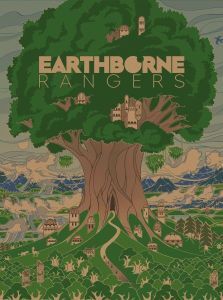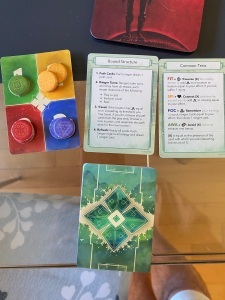Tabletop Tuesday — Earthborne Rangers (Introduction)
It’s Tuesday, my head feels like it’s going to snap in half, and mostly it’s the weather’s fault, which is why today’s topic feels particularly on point: a game where our damage to the earth has been ridden out, people are returning to exploring the planet post-recovery (though things are still not perfect, people have definitely learned to work with Mother Nature, not against her) and thus, the players are brand new explorers known as Earthborne Rangers.
Why Only an Introduction, ‘Nathan?I wanted to have a much more thorough review of this game by the time I talked about it, but see above re: headache, and also something else happened: almost our entire scheduled play time was taken up by… getting ready to play.
I need to preface here with one thing: once you get going, I think the game will absolutely drop into a groove, but something—iconography, word choice, the way the instructions are written, just… something—about this game doesn’t seem to slip into intuitive at any point during the initial learning curve.

It’s a deck-builder, and your character is created by first choosing “aspects,” which are the currency of all actions. Basically, you’ll get a 3, two 2s, and a 1 in four aspects of Awareness, Spirit, Focus, and Fitness. Now, choosing this felt a little “Am I supposed to know what the difference between Spirit and Focus and Awarness is?” and so we had a few minutes of reading and discussion of the rules and mostly it came down to “vibes”—which, I think, ultimately is probably the way to go for your first game. Just… choose.
Then you choose your Ranger’s background (how they grew up, and we all just sort of decided “meh, pick one” here and then chose more-or-less at random from the options of each background in more of that going-with-vibes way). After that, it’s time for character specialization (I’d liken this to their character class or profession: what they’ve learned to do—easily the most overwhelming as you’re trying to choose cards that will be giving your character its core functionality, but… what does any of the text on the cards mean? It’s hard to tell when you haven’t played yet). This was a pretty big stumbling block, but we let our backgrounds guide us here. I was a Traveler as my background, so I nabbed Explorer as my profession. Each profession also comes with one of two roles you can play under (represented by a single card that just stays in play).
 It took us so long to get this far. So long.
It took us so long to get this far. So long.I chose the one that seemed less complicated, because by the time we’d all chosen our cards from the specialty, we’d glanced at the clock and realized we might not even get to actually playing at the rate we were going. Again, I think this came down to not understanding what choices we were making in the context of the cards we’d already chosen from earlier: I was left with the impression that my aspect of 1 in Awareness would mean playing the Awareness cards would be pretty darn rare for me, so I really hemmed and hawed over which of the green cards I’d be adding to my deck, if any. Everyone else seemed to have a similar sticking point of not quite getting how to balance their deck and which cards to choose (because you don’t just get all of them, you choose from the pile and leave some behind).
Next comes their personality (some adjectives, basically, and another set of cards with iconography that had us all scratching our heads and re-reading the rules), and finally, their outside interest—which is kind of clever, it’s left-over cards from other people’s specializations. Because we had four players, eventually, all the piles were empty.
If I have one criticism to level at Earthborne Rangers right off the bat, it’s this: one more page of instructions with suggested character builds for two, three, and four player campaigns. We all would have cheerfully accepted a “just try this” approach from step one. We could have undone it after if we wanted to try building a character from scratch after, but it felt like a glaring omission to have no “if you want to get started, try this character load-out.”
All that to say, our ranger deck generation took us ages. We had to keep re-reading the instructions, weren’t sure we were doing it right, one of the players realized they had to have “Conduit” cards or their character wouldn’t work at all, and I had the very wrong idea about how my aspects would work even after I read and re-read the instructions, but eventually, we were ready to play the introduction scenario of… delivering cookies.
Game OnIn the end, we only had time to play the introduction scenario of delivering said cookies, but it was pretty obvious from the start that one of the strengths of Earthborne Rangers is in the fluff and the artwork. Everything is gorgeous, the text is somewhere between amusing and meditative, and while we were quite literally delivering cookies, we started to get the hang of the turns, how (some of) our cards worked, and I had my lightbulb moment of finally understanding the symbols and iconography and how the cards worked alongside the aspects—icons denote which cards can be used to boost or add to the overall cost of any given action, which means I wasn’t truly locking myself down as much as I thought I was way back when I picked my aspects card—and also we soon realized the “basic” actions weren’t “also-rans” but actually ones we’d be using quite a bit. It’s odd to have a hand full of cards and just as often think, “I should just use these to do a basic action,” especially coming off Frosthaven, but the basic actions often seemed to be the way to go.
That isn’t to say we didn’t have flavour and feel to each of our characters. I started to “get” some of my card combinations, and it’s really enjoyable to have a little run of “okay, I’m doing this, which means this, but also, I get to boost your attempt to do that and we’ve made more progress here, too.”
The “progress” mechanic of putting tokens on a card until you’ve got enough on it to clear it, explore it, or otherwise have dealt with it is a core mechanic that quickly lends itself to the group focus, and since it’s a co-operative game where you don’t even have to take turns in a particular order (but no one can go twice in a row), there’s a great deal of flexibility and cross-table chatter with “Okay, if you did that first, and I helped, then he could do that, she could do this, and finally, I can finish up with this, and I think we’ll have it sorted?”
The randomness comes from a deck of cards that have four modifiers to each aspect on them, as well as one of the “trigger” symbols that activates special abilities of the various locations and creatures currently in play on any given turn. But mostly, you’re all aimed at a particular goal, and working together to get there in this strange new Earth.
It’s a legacy game, in that you track your progress on a campaign sheet, your decks change as you play (I’m told, we’ve not gotten that far yet), and there’s a story unfolding (so far it’s been a story about cookies, but I trust that will perhaps get deeper in time). That said, it’s clear you could undo everything and start over without too much effort—just putting all the cards back where they belong in their little holders and starting anew.
I think we choose some pretty standard options in the combinations (One of the players paired Artisan with Artificer, for example; and I’ve got the Traveler background with the Explorer profession), but you could definitely shake things up thematically by altering the core options of character creation, and I definitely imagine even from just our short time with it that two players would have a different experience than four.
Initial ThoughtsThey’re very initial thoughts, but so far, so good, with the caveat of the learning curve. I originally tried to watch a how-to video, but bounced off two different videos after finding both just as confusing as the rule book itself. This one really does feel like a game where until I played, I didn’t get it, and people talking me through it and reading the rulebook just wasn’t enough. It’s an odd feeling, and a rare one—I usually understand easier from having people explain things to me, but something about the iconography and the perhaps-too-much-vibes in the terminology chosen for the various components and aspects of the game just seemed to make it beyond my grasp until I was doing the thing. After that, it clicked in pieces at a time, but was much, much easier to parse.
I’ll come back with a more detailed walkthrough later, once we’ve played more, but I will say that it definitely felt like a breath of fresh air after being so repeatedly frustrated with Frosthaven (which is a whole other post for another day). If nothing else, we’re looking forward to a game set in a vibrant world with wonderful flavour with a truly different feel.



